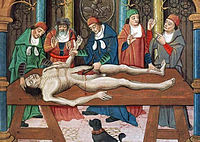
Photo from wikipedia
Trust is a fundamental component of relationships between people who live and work within a particular environment. This network of relationships is often referred to as social capital which appears… Click to show full abstract
Trust is a fundamental component of relationships between people who live and work within a particular environment. This network of relationships is often referred to as social capital which appears stronger in communities and individuals who are more progressive and confident in their ability to succeed (Harris et al., 2013; Fuller, 2014). As a measure of academic capital, intellectual inquiry, research dissemination, and scientific acuity build authority that strengthens knowledge and informs expertise. In the culture of trust, the will to learn is met with the capacity to provide a space of safety, reassurance, authority and intellectual consolidation between what the learner seeks and what the teacher is able to provide. By definition, “trust” relates to an “assured reliance on the character, ability, strength, or truth of someone or something” (Harris et al., 2013). Trust is also perceived within the context of the relationship and the expectations that people bring to the relationship. In the teacherstudent contract, teachers and students judge performance of certain expected behaviors as a measure of success of the teaching and learning experience. Trustworthy relationships between educators and students are important for students’ ability to learn (Raider-Roth, 2005; Van Maele et al., 2014) and for effective teaching to occur (Schulte-Pelkum et al., 2014). Several reviews of literature on trust emphasize the importance of this concept in an educational environment and its impact on students and teachers (Van Maele et al., 2014). In a trusting environment students feel encouraged to actively participate in learning (Gregory and Ripski 2008) and engage more openly in the educational process (Schulte-Pelkum et al., 2014). Trust is viewed as a basic component of social relations enabling students to fortify their solidarity and social cohesion, and generate mutual expectations and obligations (Addi-Raccah, 2012). Anatomy teaching and learning have transcended the confines of the standard academic curriculum. In an era where platforms are constantly expanding, classroom profiles are rapidly evolving and anatomy exceeds its presence within an autonomous virtual domain, trusted resources and trusted facilitation in helping students navigate a plethora of anatomical content become an academic necessity. Yet in the wake of unlimited access to anatomic knowledge, the student’s need for reassurance, clarification, endorsement and teacher recommendation is prevailing. Similarly, trusted resources built on scientific rigor, empirical findings, and peer review offer a mainstay for academic reference and development. In the absence of or through an erosion of trust, teacher behaviors, student behaviors and student academic achievement are equally impacted. We believe that in the modern era of anatomy education student-teacher and studentstudent trust is especially important. In this time of change and evolution of the anatomy curriculum (Drake, 2014; McBride and Drake, 2018) trusting relationships between faculty members and students are essential for cooperation with teachers and required for developing an inquiring mind that is open to questioning and clinical reasoning when learning difficult concepts. It would seem pertinent therefore to explore ways in which trust can be earned, maintained and strengthened within the proverbial academic contract. As anatomy is often taught early within curricula, there is an opportunity for building trust early and aiding students to transition and adjust to health care professions education. Connectedness leads to accelerated motivation for learning and inquiry and subsequent achievement. Trust may be earned by demonstrating a student-centered approach in the learning environment. Especially in the field of anatomical sciences, the teacher should be the leader in the classroom but at the same time show commitment to active participation in course related activities as a partner in the process of learning, engaging with both the subject matter and learners at hand. The teacher also forms a vision/direction of what needs to be done in the learning environment and is present to guide students as they accomplish their defined learning objectives. As trust builds, students are also more likely to seek help when needed and more comfortable with acknowledging their deficiencies. In dissection, or other laboratory activities, trust relationships diminish student stress associated with their first exposure to cadavers (B€ ockers, 2015). Trust could also be demonstrated through awarding accountability to students for their own learning. Apportioning a percentage of the grade toward team-based assessment and placing value on nontraditional discipline-independent skills (Evans and Pawlina, 2015; Lachman and Pawlina, 2015) reflect a sense of teacher trust in student contribution to their own outcome. With increasing emphasis on peerand near-peer teaching, a trustworthy relationship with peers provides students with the ability to shape their own learning and their own independence and not simply adapt to the way of the teacher. The trust demonstrated by body donors (Chiu et al., 2012), who are often described as students’ first patient in their careers, can be the first step in establishing a trusting patient-physician relationship in the future. For the past decade, Anatomical Sciences Education (ASE) has developed a presence in the field of anatomy education and has earned respect from peers and readers from other disciplines. This trust in ASE is reflected in the number of citations the journal receives each year and its impact factor of 3.198, which places ASE fourth out of 41 recognized resources in the Education, *Correspondence to: Dr. Wojciech Pawlina, Department of Anatomy, Mayo Clinic College of Medicine and Science, Mayo Clinic, 200 First Street SW, Rochester, Minnesota 55905. E-mail: pawlina.wojciech@ mayo.edu Published online in Wiley Online Library (wileyonlinelibrary.com). DOI 10.1002/ase.1767
Journal Title: Anatomical Sciences Education
Year Published: 2018
Link to full text (if available)
Share on Social Media: Sign Up to like & get
recommendations!